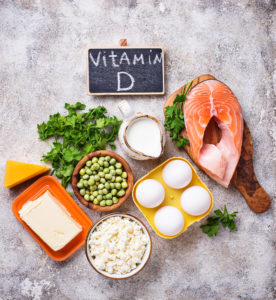As daylight hours decrease and winter sets in, it’s important to make sure you’re getting enough vitamin D. We look at the ways you can give yourself a boost…
Vitamins and minerals play important roles within our body – and vitamin D is no exception. It helps to regulate calcium and phosphate, which is vital for strong, healthy bones, teeth and muscles. Yet, surprisingly, as many as 13% of the world’s population is deficient.
How much do we need?
 So how much do we need? That depends on your age. The NHS states that babies up to 12 months need 8.5 to 10 micrograms of vitamin D a day. Children from the age of 1 and adults need 10 micrograms a day. This includes pregnant and breastfeeding women and people at risk of vitamin D deficiency – care home residents, people covering up large areas of their skin while outside and those with darker skin tones.
So how much do we need? That depends on your age. The NHS states that babies up to 12 months need 8.5 to 10 micrograms of vitamin D a day. Children from the age of 1 and adults need 10 micrograms a day. This includes pregnant and breastfeeding women and people at risk of vitamin D deficiency – care home residents, people covering up large areas of their skin while outside and those with darker skin tones.
That’s because one way to get vitamin D is from the sun – we produce it when our skin is exposed to sunlight. In the UK, from around the end of March to the end of September, most of us should be able to get all the vitamin D we need – giving us even more of a reason to get outside and enjoy walking or even a spot of gardening.
So, as autumn creeps into winter – between October and early March – it’s harder to get enough sunlight exposure to produce this necessary vitamin. This is where diet comes into play. Good dietary sources include:
Fish: Fatty fish and seafood are among the richest natural food sources of vitamin D. Canned salmon, tuna, mackerel, oysters, shrimp, sardines, and anchovies are good sources. Enjoy with salad, topped on a jacket potato or as part of a sandwich to up your intake.
Mushrooms: Mushrooms are the only plant-based sources of vitamin D. Try a creamy soup packed with mushrooms – fry onion and garlic, add mushrooms, stock and water and a little milk, and boil until soft. Add a splash of milk, then blend – perfect for warming winter lunches.
Eggs: Egg yolks – especially free-range eggs – are a great source of vitamin D. This is because hens that can roam outside in the sunlight produce more vitamin D in their eggs than hens that are kept indoors. Luckily, eggs are so versatile and make for a great hearty breakfast with minimal effort. Boiled eggs and soldiers, scrambled, or poached are easy to prepare and set you up for the day.
Fortified foods: Vitamin D is often added to food staples – like bread, fortified dairy products and breakfast cereals – perfect for topping up your intake.
Supplementing your levels
Tablets & sprays: If you don’t think you get enough vitamin D from food or sunlight combined, supplements are at hand. It’s best to get your vitamin D levels checked before you start any supplements so that you can be sure you’re taking the right dose. Over time, too much vitamin D from a supplement can lead to calcium build-up (hypercalcaemia), which can weaken bones and damage the heart and kidneys. If you do choose to take vitamin D supplements, 10 micrograms a day will be enough for most people and are available over the counter.
Lamps: You can buy lamps that emit UV-B radiation to stimulate vitamin D production. These are often called ‘light therapy’ and are suggested to help people suffering from SAD – seasonal affective disorder – a type of depression linked to the darker seasons. They are useful for people who find it hard to absorb vitamin D, but there are easier ways to supplement the levels for most people. Plus, they can be dangerous if used too much.
Are you low?
There are various symptoms which can mean you’re low in vitamin D but which could also be linked to something else. Some of the symptoms include:
- being prone to infection
- fatigue
- depression
- hair loss
- muscle and/or bone pain.
If you think you could be low in vitamin D, talk to your GP and ask for your levels to be checked.
Diabetes & vitamin D
There is some evidence in new research that vitamin D can play a role in preventing Type 1 diabetes. For example, a Finnish birth-cohort study found that children who were regularly given 2000 IU daily during the first 12 months had a lower relative risk of developing Type 1 diabetes by age 30 compared with those who had less.
Covid-19 & vitamin D
There have been several reports about vitamin D reducing the risk of coronavirus. While more studies are ongoing, the NHS says there is currently not enough evidence to support this and not to take more vitamin D than you need.
